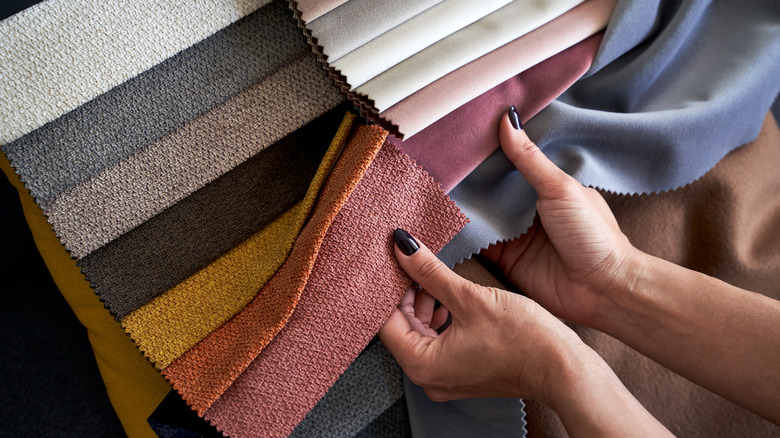How To Choose Fabrics For Your Home That'll Stand Up To Stains
When investing in a new piece of upholstery or any other fabric element to introduce to your home, aesthetics are one thing. However, it is also essential to make a fabric selection that withstands the wear and tear of real life ... especially when you're talking about, say, a sectional in the family room of a home with kids, pets, and movie snacks. It would be extremely frustrating (and expensive) to find out that the first pizza, coffee, crayon, or red wine stain to hit your new furniture couldn't actually be cleaned. But with so many different drapery, pillow, or sofa fabric types, to say nothing of the additional stain guard treatments out there, how do you know which fabrics will actually hold up well to stains?
As a professional interior designer, I recommend that clients keep both aesthetic preferences and longevity in mind. As the old truism goes: Do it once, and do it right. To maximize the stain-resistance of your home fabrics, look for options specifically blended for performance (often with a mixture of natural and synthetic fibers) or for those manufactured with waterproof coatings, especially for high-traffic upholstery. With a better understanding of what various fiber types bring to the table — as well as if, or how, a fabric is coated for stain protection — you will be able to select smart, durable options for all of your home textiles.
How natural and synthetic fibers impact home fabric stain resistance
I'll start with a little fabric 101, as knowing the basic properties of what you are buying will help you make informed decisions about the fabrics you bring into your home. There are two types of fibers that are used to make fabrics: (1) natural fibers that come from plant, animal, or mineral sources; and (2) synthetic fibers, which are man-made with chemically-produced materials.
The most common natural fibers used for home fabrics are cotton, leather, wool, linen, and silk. Aside from leather, natural fibers generally tend to be more absorbent than synthetic fibers, making them susceptible to staining when the fabric absorbs the spill. Leather, on the other hand, is naturally water-resistant, meaning it will repel liquid better than the other natural fiber alternatives. However, when a deeper stain does occur on leather, depending on the type and finish coat of the product, it can sometimes be so delicate to clean leather furniture that you need to bring in a professional. Plus, prepare to shell out a pretty penny for high-quality leather home goods.
Synthetic fibers that are often used in home textiles include polyester, nylon, acrylic, olefin/polypropylene, acetate, and rayon/viscose (a semi-synthetic fiber derived from natural wood pulp but put through chemical-processing). Synthetic fibers are usually more durable and more liquid-resistant than natural fiber fabrics, meaning they are typically easier to clean and resist stains better. However, most synthetics do not make for nice home fabrics on their own thanks to a variety of innate characteristics like no breathability, pilling, rough texture, fading, and more. Therefore, many upholstery companies will blend natural and synthetic fibers in their home fabrics to specifically create options that have a combination of qualities from both types of fibers.
Performance blends and hydrophobic coatings have ideal stain protection for upholstery
With all that in mind, let's get into my recommendations. First of all, I do highly suggest blended fabrics. They are an extremely popular choice for durable, stain-resistant home fabrics. When these blends are specifically made for high-traffic upholstery, they are often called performance fabrics. By combining natural fibers — known for their beauty, breathability, texture, and versatility of design — with the durability and stain-resistance of synthetic fibers, you'll end up with fabric that is wonderfully easy to clean and maintain. Another option for added stain protection: Hydrophobic coatings, such as Scotchgard, that can be applied to a fabric after purchase to repel liquid. However, most of these coatings can only be applied to washable fabric types, need to be regularly reapplied to keep working, and can void a piece's warranty. So, while they may give additional protection to a fabric usually more susceptible to stains, they may not be an ideal long-term or low-maintenance solution for everyone.
Finally, there's also the high-tech options — if you can afford them. These days, there are companies producing incredibly soft, beautiful performance fabrics that are nearly impervious to stains. Some, like Crypton and Sunbrella, use a variety of fibers that are treated with a waterproof coating at a molecular level (meaning it lasts for the lifetime of the fabric), causing the fabric to make liquid bead up instead of absorb, so it can simply be wiped away. Again, though, these options are pricey.
Whichever one of these options you take, you will have peace of mind knowing your new furniture will be able to hold its own against spills and stains. Make the choice that's right for your budget, family, and style.


